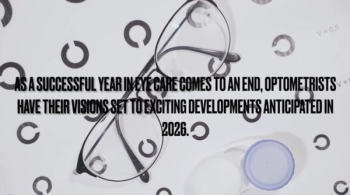
Decreased vision on the left side leads to hemianopia diagnosis
A 39-year-old African-American female presented to The Eye Center at Southern College of Optometry with complaints of blurred vision, loss of side vision to the left, and trouble with mobility. S
A 39-year-old African-American female presented to The Eye Center at Southern College of Optometry with complaints of blurred vision, loss of side vision to the left, and trouble with mobility. She was diagnosed with hypertension, hypercholesterolemia, and type II diabetes mellitus in 2007 when she was admitted to the hospital for a stroke. The stroke left her with left-side weakness, and she occasionally suffered seizures.
More recently, she had also reported being diagnosed with systemic lupus erythematosus. Her family ocular history was unremarkable-her paternal grandmother had diabetes, and her mother had hypertension. She smoked several times a week and reported no alcohol or recreational drug use.
Her medications included prednisone, levetiracetum (Keppra, UCB), amitriptyline (Elavil, AstraZeneca), metformin, and simvastatin (Zocor, Merck). She reported an allergy to sulfa antibiotics. Blood pressure was measured manually in-office at 111/76 mm Hg.
Case presentation
Entering visual acuities were 20/70 OD and 20/400 OS, which improved with pinhole to 20/30 OD and 20/50 OS.
Confrontation visual fields were restricted nasally OD and restricted in all gazes OS. Extraocular motilities were full in all gazes; cover test showed orthophoria at distance and near; and pupils were equal, round, reactive to light and accommodation with a positive afferent pupillary defect (APD) OS. Goldmann applanation tonometry was 19 mm Hg OD and 20 mm Hg OS.
A new subjective refraction improved vision to a slow 20/20 in OU. Biomicroscopy was unremarkable OU. Examination of the posterior segment showed optic nerve pallor, more severe temporally OS compared to OD (see Figures 1 and 2). There was also lattice degeneration in the periphery OU but no signs of retinal breaks present. No diabetic retinopathy was noted OU.
A baseline ocular coherence tomography (OCT) of the optic nerve and 24-2 Humphrey Visual Field were ordered for each eye. The OCT showed that the retinal nerve fiber layer (RNFL) was thinned in all quadrants, with no cupping involved. This indicated that the nerve findings were likely not due to glaucoma (Figure 3). The 24-2 HVF test was unreliable with severely depressed fields in both eyes. However, there appeared to be small, subtle “islands” of vision in each eye, so we decided to repeat the HVF test, but with the 10-2 protocol this time, in hopes of getting more reliable results. The 10-2 visual field revealed left hemianopic defects in both eyes respecting the vertical midline, likely representing a lesion on the right side of the brain and visual pathway.
We spoke with the primary-care physician (PCP) on the phone to see if the patient had recently had neuroimaging performed of the brain and orbits. She had not, so we scheduled magnetic resonance imaging (MRI) with and without contrast to rule out a new lesion of the visual pathway given her optic nerve pallor findings in each eye and her complaint of relatively new visual field defects. Given the visual field defects, an orbital MRI was ordered to rule out compression of the optic nerves, and a brain MRI was ordered with an emphasis on the right optic tracts and right occipital lobes to rule out a lesion in these areas.
The brain MRI showed chronic, ischemic changes to the body and anterior horn of the right lateral ventricle and right optic tract, which explained the patient’s visual field defects. When it was compared to the MRI performed in June 2010, there was no damage progression in any part of the brain, indicating the damage responsible for the visual field defects was stable and longstanding from the original stroke incident. The left hemisphere, cerebellum, and both occipital lobes were normal. Given the patient’s decreased ability to read as well as her decreased ability to see things to the left side of her vision, the patient was promptly referred to our low vision department for a prism and a low vision device evaluation.
Discussion
Stroke is the most common cause of homonymous hemianopia, followed distantly by trauma and brain tumors, and very rarely Alzheimer’s disease.1 Most lesions causing hemianopsias were located in the occipital lobes, followed by optic radiations, multiple locations, optic tracts, and lateral geniculate body, while a small percentage was determined to be idiopathic.1
An afferent pupillary defect can assist in the diagnosis. Its presence on the side of the hemianopia indicates an optic tract lesion.1 It is very important for these patients to have eye examinations after suffering a stroke; only 8 percent of patients have normal vision after a stroke.2 The other 92 percent have visual impairments such as perceptual deficits, eye movement deficits, low vision, and visual field impairments.2
We would expect the field loss to be stable within two weeks, if the damage is caused by ischemia. After that, no recovery of the field is expected, and it is not likely to progress.3
Confrontation fields can uncover large areas of field loss, which can then be verified with an automated or manual perimetry.4
Homonymous field defects are unfortunately correlated with a poorer prognosis for recovery and stroke rehabilitation.3 These patients can have marked difficulty with activities of daily living (ADL), such as hygiene, meal preparation, and driving.4
They can also have significant difficulty with reading, depending on which side of the field is affected.3,4 With left-sided field loss, patients often have difficulty returning to the beginning of a new line, while with right-sided field loss, they have trouble making reading saccades into the blind field to the next word.4
Patients with permanent visual field loss can learn how to compensate for the lost vision. Some adapt by making small saccades into their blind spots until they find targets.5 This is effective but can take a long time, which is not ideal when trying to maneuver around obstacles.
Other patients develop a quicker way to evaluate things inside their hemifield defects by making large saccades to purposefully overshoot objects so as they return to primary fixation, their eyes will come to rest on the target.5 But what if a patient has trouble learning this on her own?
While there is no uniformly accepted treatment for either homonymous hemianopia or visual neglect” prism has been found to improve symptoms of field loss.6 Because these conditions greatly affect mobility and ambulation, finding successful treatment options is important to maintaining a stroke patient’s independence. Due to the often permanent field damage, treatment and rehabilitation is focused on utilizing whatever vision remains.3
In a study conducted by Bowers et al, 43 patients were fit with prism glasses.7 A small group of patients continued to wear prism long term for a large portion of the day. These patients reported that prism was useful for avoiding obstacles in their blind spots. They also found that practices which fit more patients tended to have a much higher success rate, as compared to the participating practices which fit fewer patients throughout the study.
The primary reason prism glasses were discontinued by the patients were because images would appear suddenly, which startled them.7 This indicated that these patients probably did not quite understand how to properly use them.
This corresponds to other studies stating that the benefit of prism may have increased testing values in office, but patients did not notice an improvement in ADLs.3
Some studies have found that prism increases patient self-confidence, which makes the fitting process worth the time, even if numbers don’t improve, because patients feel better.3 Prism glasses prescribed for field defects is an area which could use more attention to better help the patients’ outlooks on life.
Given our patient’s proven stability of her right-sided brain and optic tract lesions, she was told to follow up with her PCP to control her underlying systemic conditions.
She will be followed every six to 12 months with dilated exams and will follow up in our low vision rehabilitation clinic as directed. She is highly motivated for low vision rehabilitation, and we hope her activities of daily living and ability to read more efficiently improve drastically with the help of our low vision colleagues here at the Southern College of Optometry.
References:
1. Zhang X, Kedar S, Lynn MJ, Newman NJ, Biousse V. Homonymous heminaopias: clinical-anatomic correlations in 904 cases. Neurology. 2006;66: 906-10.
2. Rowe F, Brand D, Jackson CA, Price A, Walker L, Harrison S, Eccleston C, Scott C, Akerman N, Dodridge C, Howard C, Shipman T, Sperring U, MacDiarmid S, Freeman C. Visual impairment following stroke: do stroke patients require vision assessment? Age and Ageing. 2009;38: 188-93.
3. Pambakian A, Currie J, Kennard C. Rehabilitation strategies for patients with homonymous visual field defects. J Neuro-Ophthalmol. 2005;25: 136-42.
4. Kedar S, Ghate D, Corbett JJ. Visual fields in neuro-ophthalmology. Indian J Opththalmol. 2011;59: 103 – 9.
5. Meienberg O, Zangemeister WH, Rosenberg M, Hoyt WF, Stark L. Saccadic eye movement strategies in patients with homonymous hemianopia. Annals of Neurology. 1981;9:537-44.
6. Rossi PW, Kheyfets S, Reding MJ. Fresnel prisms improve visual perception in stroke patients with homonymous hemianopia or unilateral visual neglect. Neurology. 1990 Oct;40:1597-9.
7. Bowers AR, Keeney K, Peli E. Community-based trial of a peripheral prism visual field expansion device for hemianopia. Arch Ophthalmol. 2008;126:657-64.
Newsletter
Want more insights like this? Subscribe to Optometry Times and get clinical pearls and practice tips delivered straight to your inbox.










































